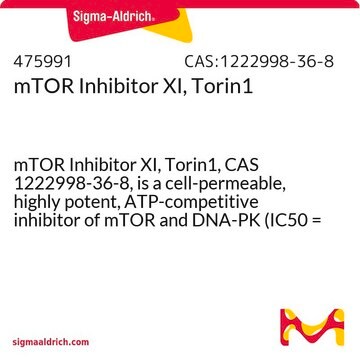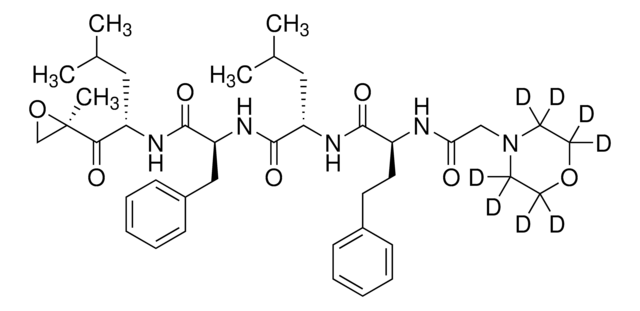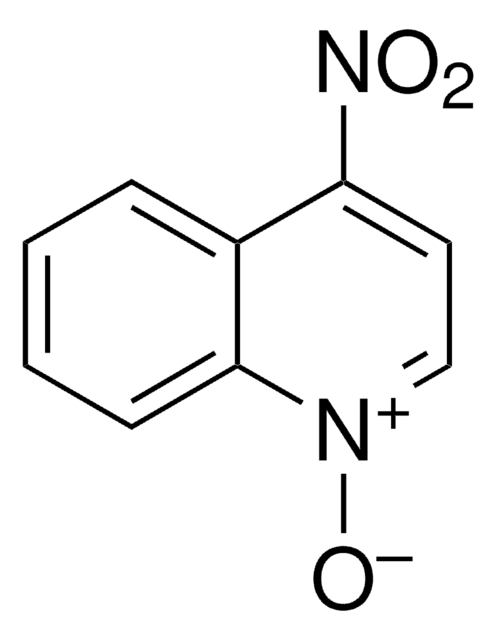SML1916
Marizomib
≥95% (HPLC), (Salinospora tropica)
동의어(들):
(1R,4R,5S)-4-(2-Chloroethyl)-1-[(S)-(1S)-2-cyclohexen-1-ylhydroxymethyl]-5-methyl-6-oxa-2-azabicyclo[3.2.0]heptane-3,7-dione, NPI-0052, Salinosporamide A
로그인조직 및 계약 가격 보기
모든 사진(1)
About This Item
실험식(Hill 표기법):
C15H20ClNO4
CAS Number:
Molecular Weight:
313.78
UNSPSC 코드:
12352200
NACRES:
NA.77
추천 제품
Quality Level
생물학적 소스
(Salinospora tropica)
분석
≥95% (HPLC)
형태
powder
저장 조건
desiccated
색상
white to beige
배송 상태
wet ice
저장 온도
−20°C
InChI
1S/C15H20ClNO4/c1-14-10(7-8-16)12(19)17-15(14,13(20)21-14)11(18)9-5-3-2-4-6-9/h3,5,9-11,18H,2,4,6-8H2,1H3,(H,17,19)/t9-,10+,11+,14+,15+/m1/s1
InChI key
NGWSFRIPKNWYAO-SHTIJGAHSA-N
애플리케이션
Marizomib has been used as a proteasome inhibitor:
- to study its effects on glioblastoma cell lines
- to analyze its effects on the aging of killifish brain
- to test its effect on protein kinase B (PKB/AKT) levels in multiple myeloma cells
생화학적/생리학적 작용
Marizomib a natural product is a marine-derived β-lactone-γ-lactam. It shows therapeutic effects against hematologic and solid tumor malignancies.. It is involved in the activation of caspase-3,-8, and -9, increases the reactive oxygen species (ROS) and promotes apoptosis. Marizomib can cross the blood-brain barrier and might have the potential to treat primary brain tumors. It possesses anti-tumor properties.
Marizomib is a second generation proteasome inhibitor with anti-cancer activity. Marizomib binds irreversibly and potently inhibits all three 20S proteasome subunits.
Storage Class Code
11 - Combustible Solids
WGK
WGK 3
Flash Point (°F)
Not applicable
Flash Point (°C)
Not applicable
시험 성적서(COA)
제품의 로트/배치 번호를 입력하여 시험 성적서(COA)을 검색하십시오. 로트 및 배치 번호는 제품 라벨에 있는 ‘로트’ 또는 ‘배치’라는 용어 뒤에서 찾을 수 있습니다.
A M Rajan et al.
Blood cancer journal, 6(7), e451-e451 (2016-07-30)
The treatment of multiple myeloma (MM) is rapidly evolving. In the United States, four drugs (panobinostat, ixazomib, daratumumab and elotuzumab) were approved for the treatment of MM in 2015. As a result of improved diagnosis and therapy, there has been
Nancy Levin et al.
British journal of haematology, 174(5), 711-720 (2016-05-11)
Proteasome inhibitors (PIs) are highly active in multiple myeloma (MM) but resistance is commonly observed. All clinical stage PIs effectively inhibit chymotrypsin-like (CT-L) activity; one possible mechanism of resistance is compensatory hyperactivation of caspase-like (C-L) and trypsin-like (T-L) subunits, in
Marizomib activity as a single agent in malignant gliomas: ability to cross the blood-brain barrier.
Kaijun Di et al.
Neuro-oncology, 18(6), 840-848 (2015-12-19)
The proteasome plays a vital role in the physiology of glioblastoma (GBM), and proteasome inhibition can be used as a strategy for treating GBM. Marizomib is a second-generation, irreversible proteasome inhibitor with a more lipophilic structure that suggests the potential
B C Potts et al.
Current cancer drug targets, 11(3), 254-284 (2011-01-21)
The proteasome has emerged as an important clinically relevant target for the treatment of hematologic malignancies. Since the Food and Drug Administration approved the first-in-class proteasome inhibitor bortezomib (Velcade) for the treatment of relapsed/refractory multiple myeloma (MM) and mantle cell
Erika Kelmer Sacramento et al.
Molecular systems biology, 16(6), e9596-e9596 (2020-06-20)
A progressive loss of protein homeostasis is characteristic of aging and a driver of neurodegeneration. To investigate this process quantitatively, we characterized proteome dynamics during brain aging in the short-lived vertebrate Nothobranchius furzeri combining transcriptomics and proteomics. We detected a
자사의 과학자팀은 생명 과학, 재료 과학, 화학 합성, 크로마토그래피, 분석 및 기타 많은 영역을 포함한 모든 과학 분야에 경험이 있습니다..
고객지원팀으로 연락바랍니다.







